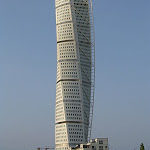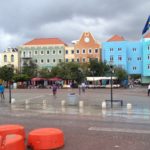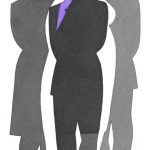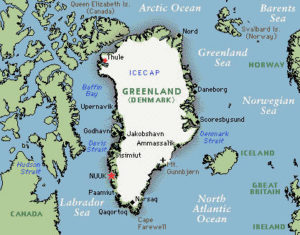
I wasn’t sure if I should include Greenland in this website. Gay life there is almost a non-event, but not for lack of a LGBT presence; we are everywhere. There has been a modest Gay Pride march since 2010 suggesting an organization that makes it happen. But mostly because the ‘scene’ is so low key, small, non-violent, integrated into the larger culture; there is no public drama or news worthy events to stir up the media.
When the historic 1996 same-sex partnership registration law came into effect in Greenland–by a Royal Danish Decree on 1 July 1996–it slipped in as quietly as a starlit night. But it was not until 2002 that any gay Greenlandic couple used the opportunity to register.
As for gay marriage (separate from registered partnerships), Greenland was distinct among almost every other country in the world. The issue caused virtually no one’s heart to skip a beat. Other countries that now allow gay marriage experienced dramatic demonstrations, resistance and delay, even in Denmark (followed by acceptance over time as the debate wore on). In Greenland there were no demands in the streets for marriage equality, no lengthy advocacy, very little governmental debate and virtually no media coverage. Indeed, one native said “gay rights have come from the work of straight people”.
A parliamentary resolution to adopt the existing version of Denmark’s marriage law was given its first reading in on 25 March 2015 and unanimously approved on the second reading on 26 May 2015. That’s two months from start to finish with hardly a whimper of opposition.
This is what happens when there is no political discrimination, no right-wing propaganda and no religion-based homophobia. The fire storms of opposition seen in Paris, Berlin and Washington were totally absent before and during the short legislative procedure. Greenland’s gay marriage emerged within a liberal society as naturally as the seasons change. The issue was human equality among the small population of less than 60,000 citizens in the country. Of course there were small pockets of disapproval among less educated and remote villagers.
Since April 2016 LGBT citizens have been able to marry in a civil or religious ceremony.
The Story of a Progressive Country
Thanks to its affiliation with Denmark (which pioneered registration of LGBT couples since 1989 and marriage since 2015), Greenland was actually the fourth country in the world to establish a registered domestic partnership law in 1989 and in 2015 it became the 11th country in the world to approve gay marriage. Today there are 20 countries that allow LGBT people to marry.
Jesper Kunuk Egede is a Greenlander by birth, who, like many of his fellow LGBT country folks, now lives in Copenhagen. He works for Technical University of Denmark, and Air Greenland Travel. He was part of the group that started the first Greenland LGBT group, Qaamaneq. He commented that the partnership law didn’t abundantly emerge into much visibility or frequency among Greenland’s LGBT couples. He told journalist Dan Allen (June 2010) “I know only of one couple who have actually had their same-sex union in Greenland, but I’ve heard of others who were married in Denmark and moved to Greenland.”
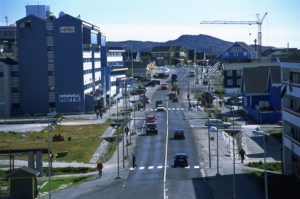 Allen went on to write, “organizing gays over such a large, rugged and thinly peopled land mass as Greenland, where roads are few, winters are long and darkly brutal, and most transportation is still by boat, has never been an easy feat”. But a brave effort was made nevertheless. In the 2007 fall issue of Passport magazine (gay travel) journalist Matthew Link interviewed Erik Olsen, a well-known radio personality who had organized a gay association called Qaamaneq [meaning ‘Light’]. Said Olsen, “I had people contacting me from all over Greenland, asking how they could get involved,” said Olsen. “At the height of our gay organization a few years ago, we would rent out a house in the old part of town and have parties with up to 50 gay and lesbian people at a time”, said Olsen. (photo left: Nuuk main street)
Allen went on to write, “organizing gays over such a large, rugged and thinly peopled land mass as Greenland, where roads are few, winters are long and darkly brutal, and most transportation is still by boat, has never been an easy feat”. But a brave effort was made nevertheless. In the 2007 fall issue of Passport magazine (gay travel) journalist Matthew Link interviewed Erik Olsen, a well-known radio personality who had organized a gay association called Qaamaneq [meaning ‘Light’]. Said Olsen, “I had people contacting me from all over Greenland, asking how they could get involved,” said Olsen. “At the height of our gay organization a few years ago, we would rent out a house in the old part of town and have parties with up to 50 gay and lesbian people at a time”, said Olsen. (photo left: Nuuk main street)
But inevitably over a few short years everyone became familiar with everyone else. “There were no new faces. It was like reading an old newspaper,” he laughed recalling how the attendance dwindled down as people moved to Denmark to meet new friends or got bored with Qaamaneq and stopped attending events. “Eventually I was the only one left so I closed the group.”
After that closure there were no efforts to mount a public LGBT event for several years. Private dinner parties, friendship networks, trips abroad and the internet met most of the social needs of the community. Indeed, the web changed Greenland’s gay landscape in recent years. “The internet has made gay dating easier in Greenland,” reported Egede, “particularly a Danish dating site called boyfriend.dk has made it easy for Greenlandic gay people to meet. Lesbians also use the same site.” The capital city of Nuuk (population less than 17,000) had a popular dance-and drink de facto gay bar (as of 2010) that was comfortably mixed called Manhattan,” he said. “The graffiti on the side of the building said for a while, Gayhattan.”
Renewed Gay Pride
Then in 2010 19-year-old stylist Nuka Bisgaard and her friend Lu Berthelsen, 24, another woman, decided to team up with a few other local Greenlanders and create a Pride celebration. 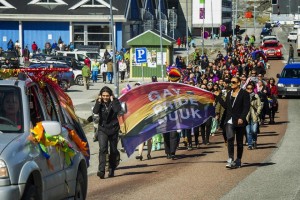 Their efforts paid off on May 15, 2010 when Pride drew over a thousand participants in downtown Nuuk, the capital, including a colorful and musical parade. (photo right) which Dan Allen noted “may not seem like much, until you know that only 57,000 people actually live in Greenland. (Put another way, that’s like five and a half million Americans showing up for the first New York City Pride.) Representatives from the country’s gay-friendly Democratic Party marched at the front of the parade, and Greenlanders of all ages and persuasions joined in, turning it into the second largest demonstration in the nation’s history.”
Their efforts paid off on May 15, 2010 when Pride drew over a thousand participants in downtown Nuuk, the capital, including a colorful and musical parade. (photo right) which Dan Allen noted “may not seem like much, until you know that only 57,000 people actually live in Greenland. (Put another way, that’s like five and a half million Americans showing up for the first New York City Pride.) Representatives from the country’s gay-friendly Democratic Party marched at the front of the parade, and Greenlanders of all ages and persuasions joined in, turning it into the second largest demonstration in the nation’s history.”
The early evening parade–with no dykes on bikes, no floats filled with go-go boys or brass bands with twirlers or bar-sponsored trucks with leather guys and popping balloons–walked peacefully and playfully through Nuuk’s modest downtown. No bible-thumpers showed up. This “watershed event” was followed by a sold out dinner at the Katuaq Cultural Center during which performances were mounted with speakers, musicians, singers, dancers–in wigs, make-up and sequins–some of which featured Nuka Bisgaard herself showing off her talents.
Bisgaard hopes this renewed united effort will inspire more openness among Greenland’s visible and invisible LGBT community. “We are trying to create a network and to break with taboos and loneliness,” she says. “A lot of young people feel lonely and afraid due to their sexuality (The age of consent here is 15.) We want to break the silence and let them know that they are, indeed, not alone. We want to create a better future in which our gay rights will also be heard in Greenlandic society.”
Gay Pride has been successfully repeated since 2010. A report from the 2012 event featured a welcoming speech by the mayor Asii Chemnitz Narup, music concerts, theatre performance by Copenhagen Gay Theatre Show, a Dance & DJ Party until midnight with performers Rosa Lux (DK), Uyarakq (GL), Derrick Barry (U.S.), Nuka Tha Diva (GL), NAIP (GL) and others.
More Pride: Hjalmar Dahl
Hajlmar Dahl ia probably Greenland’s best known human rights and LGBT activist. He is vice chairman of ICC-Qaamaneq gay organization.
On March 4, 2013 Greenland’s first council on human rights convened in Nuuk with the purpose of advancing and protecting human rights in Greenland. At the initial meeting, the Council adopted its rules of procedure and appointed Hajlmar as it’s chairman. The council is comprised of a broad representation of various organizations in Greenland and acts in an advisory role to the government and does not have a political function.
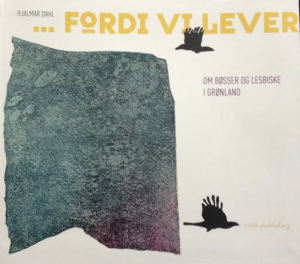 Also, Hjalmar is the author of the first book about homosexuality in the country, ‘Because We Live’ which is about living conditions for gays and lesbians in Greenland before the modern liberal era began. (book cover, photo left)
Also, Hjalmar is the author of the first book about homosexuality in the country, ‘Because We Live’ which is about living conditions for gays and lesbians in Greenland before the modern liberal era began. (book cover, photo left)
Dahl gives an insight into the political, legal and religious development, and factual knowledge anchored in nine honest and personal life stories. It tells the good and bad about being gay in Greenland. It’s also also about love crossing genders (transgenders).
Years before the book was published, said Erik Olsen, “We were regarded with more distaste than murderers and child abusers… the perception of gay people has changed over time, but there is still a long way to go.” That long way has come and gone. Greenland is now one of the most progressive LGBT countries in the world. Link to Hjalmar Dahl’s book.
Living Gay In Greenland: Interview with Jesper Egede
More recently (June 2015) I traded e-mails with Jesper and asked him about recent LGBT life in Greenland. By coincidence our exchange happened the same week that gay marriage was unanimously approved by the Greenland parliament. Jesper wrote, “Gay marriage was ok’d on Wednesday May 26 in Greenland. The marriage bill was proposed by one of my straight friends Justus Hansen, who happens to be a member of the most right-wing party in Greenland (right wing in a good, non-fascist way).” (See report)
GlobalGayz: Can you make a general comment of being gay in Greenland? how is the general atmosphere for gays? The country is considered to be liberal toward LGBT people. How long has it been this way?
Jesper Egede: Being gay in the bigger towns in Greenland has become a lot easier these past 10 years. Homophobia is less prevalent in most towns, but I’m pretty sure that it’s still quite hard in the smaller communities. That’s why a lot of gay people have moved to the two largest towns, the capitol of Nuuk and Sisimiut. Another large group of gay people have moved to Denmark.
I’ve encountered all kinds of homophobia in Greenland but mainly from people who don’t know me. I’ve also encountered the opposite, where even the mechanics from my old workplace at Air Greenland would come up to me when I was out on town and saying stuff like ‘We’re cool with you being gay’ or ‘I didn’t know any gay people before you and you’re ok’. (I hope that doesn’t come off as self-centered).
That we got the liberal law of Registered Partnership early on is something to be proud of but it was never much of an issue in the public. I lived in Denmark at the time, and as I remember it, suddenly the law was just there in Greenland. I noticed because the conservative party protested and some clergy did also.
GG: What is the best thing about being gay in Greenland? what is the not-best thing?
JE: Well, homophobia and isolation would be the worst. It may seem kind of weird but I find that the best is that it is actually not gay people who have fought the fight for equality, but straight people. Obviously, there has been some nudging from gay people and in recent years we’ve had two organizations for gay people and several prides but, in general, the gay rights have come from the work of straight people. And I think that is beautiful because it proves that there are selfless people out there willing to fight for a cause and not something they stand to gain from personally.
GG: Is there much or little homophobia there? from religious people? from politicians? from neo-nazis?
JE: I couldn’t help but smile a bit. Neo-nazis in Greenland is such a strange and completely foreign thought 🙂 It’s not that we do not have racist but that’s mainly from people who dislike Danes and other foreigners taking jobs in Greenland. There is homophobia there. Some priests are against gay marriage but I don’t think the worst homophobia comes from the church but individuals who don’t understand homosexuality. You have to remember this is an enormous country with only 56,000 people. The length equals that of Toronto to the Florida Keys or NYC to Denver. It’s the size of France, Germany, Spain, Italy, Switzerland, Belgium and the United Kingdom combined. With 56,000 people with no roads between towns and villages. It’s not a place where the winds of change and openness to new ideas come easily. But it’s getting better as the prides have shown. In the very first pride, 1,000 people attended and that is in a town of 15-16,000 people. That is way higher than the number of gay people.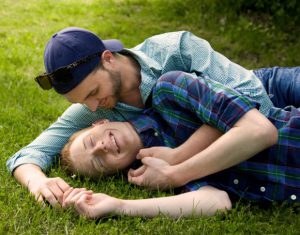
GG: are there openly gay teachers? police? politicians? business people? clergy? anyone else?
LE: Hjalmar Dahl of ICC is openly gay. I was head of PR and Marketing for Air Greenland for many years, openly gay. The former President of the LBGT organisation Qaamaneq, Erik Olsen, is an announcer on radio. A prominent and popular Greenlandic author Niviaq Korneliussen is openly gay. A former leader of the national theater is gay. I’m sure there are openly gay teachers. I don’t know about police people.
GG: when you first realized you were gay were you scared–of your family–of your school mates–were you mistreated? Was coming out difficult or easy or nothing special?
LE: Coming out is usually not easy but my coming out wasn’t that hard, either. As a child, some people were teasing me as I was quite effeminate but I was not beat up for being gay. In the teenage years, all my best friends, teachers and siblings knew I was bi or gay. It wasn’t until I was 20 I came out to my parents but it’s not as if they were surprised. My dad never understood homosexuality and the thought of two men together was disgusting to him but he said: “I’m not surprised even if I don’t understand it. Anyway, he’s my son and I love him just as much as my other kids.” And I brought home my boyfriends like my siblings would bring home their partners and there was never a problem. I actually respect my father for being cool about it. He wasn’t a homophobe in the sense that he disliked gay people because he liked most of my gay friends and partners, he just could not understand the idea of two men touching each other sexually.
End of interview.
Another Greenland Book: a Turning Point
A minor but important milestone in Greenland’s LGBT history was the publication by Niviaq Korneliussen, a twenty-seven-year-old Greenlandic author. The New Yorker magazine called it “a turning point in the island’s literary history. Korneliussen’s début novel, ‘Homo Sapienne,‘ published in 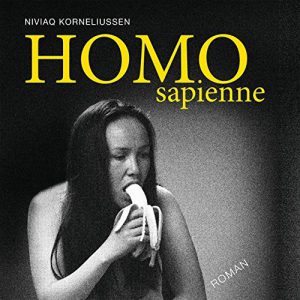 2014, is a work of a strikingly modern sensibility—a stream-of-consciousness story of five queer protagonists confronting their identities in twenty-first-century Greenlandic culture.”
2014, is a work of a strikingly modern sensibility—a stream-of-consciousness story of five queer protagonists confronting their identities in twenty-first-century Greenlandic culture.”
The book’s characters–two lesbians, a gay man, a bisexual, and a transsexual–get drunk and have one-night stands; the Greenlandic prose is flecked with Danish, English, and snippets of SMS messages and Facebook posts. (book cover right)
The novel has made Korneliussen “perhaps the territory’s most widely read living novelist, and the first of a new generation of Greenlandic writers to find a true readership outside of her native land.”
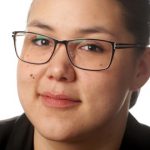 The novel is fundamentally about love, friendship, and family ties, portrayed through people who don’t exactly fit with the norm. Reviewer Milik Novel said “while many readers think the novel is fantastic, riveting, and funny, others find it ‘too much’ and indecent precisely because of the lesbian, gay, and bisexual feelings that are irrelevant to other people. Yet isn’t that what a good book should do? Reach out to our inner feelings about taboo topics, and touch the prickly hidden feelings about sexual identity?” Read the New Yorker interview with Korneliussen by Alastair Gee. (photo left Niviaq Korneliussen).
The novel is fundamentally about love, friendship, and family ties, portrayed through people who don’t exactly fit with the norm. Reviewer Milik Novel said “while many readers think the novel is fantastic, riveting, and funny, others find it ‘too much’ and indecent precisely because of the lesbian, gay, and bisexual feelings that are irrelevant to other people. Yet isn’t that what a good book should do? Reach out to our inner feelings about taboo topics, and touch the prickly hidden feelings about sexual identity?” Read the New Yorker interview with Korneliussen by Alastair Gee. (photo left Niviaq Korneliussen).
History of Same-Sex Unions in Greenland
I found this citation from a 2011 book that describes the history of how the gay partnership law came into being : ‘Odd couples : A History of Gay Marriage in Scandinavia’ by Jens Rydström.
“On July 1, 1996 one week after the Icelandic partnership law came into effect, the Danish law be came effective in Greenland, but the legal process had begun long before. Since Greenland is an autonomous part of the Danish kingdom, its local legislature has the right to adopt or reject most laws enacted in Denmark, and it can also propose laws valid only in Greenland.
“With 56,000 inhabitants scattered over a vast area, Greenland has never provided the urban culture that was the breeding ground for homosexual subcultures and the rise of gay and lesbian consciousness. Social control in Greenland has always been strict, but the prevailing social climate is one of tolerance, and the intro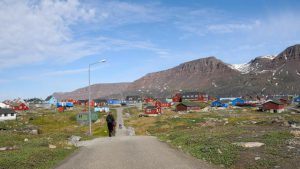 duction of the partnership law was smooth and stirred no debate. In 1993 a new Marriage Law had become effective in Greenland.
duction of the partnership law was smooth and stirred no debate. In 1993 a new Marriage Law had become effective in Greenland.
“The following year, the then Minister of Social Affairs, Henriette Rasmussen, proposed that the Danish law on registered partnership should also be enacted.“The background for this proposal is that this year is the United Nations’ Year of the Family, and it is important to establish that there are family forms other than the nuclear family,” she said when she presented the proposal.
“The debate in the Greenlandic Parliament, the Inatsisartut (or Landsting), was short and sober. Most members voiced their support for the proposal, but there were some critical voices. But even they did not vote against the proposal in the end.
“The final proposal to ask the Danish Government to make the law on registered partnership effective in Greenland was carried by 15 votes and 12 abstentions. No one voted against it.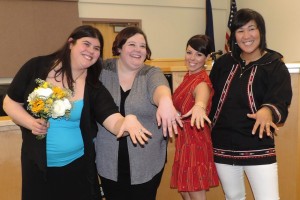
“Subsequently there was some debate in the Greenlandic press, but there seemed to be a consensus that a law on registered partnership was a good thing, and that those members of the Inatsisartut who had spoken against it were prejudiced.
“After the Parliament’s decision, however, it took more than two years for it to work its way through Danish bureaucracy, probably a sign that the question had a low priority in both capitals. It was not asked to be speeded up in Nuuk, and it was not pressed for in Copenhagen.
“When the law was made effective in Greenland by a Royal Danish Decree on 1 July 1996, there was no media coverage whatsoever, and it was not until 2002 that any gay Greenlandic couple used the opportunity to register.
“(Thus, the 3 small states in the western periphery of the Nordic area have reacted very differently to the challenge of same-sex unions. Iceland enthusiastically embraced the new order. Greenland accepted it without much debate, and the Faroes flatly refused to introduce it at that time.) ”
[Citation: Rydström, Jens : ‘Odd couples : A History of Gay Marriage in Scandinavia’. Amsterdam : Amsterdam Univ. Press, 2011.
ISBN 978-90-5260-381-0.]
URL: http://nbn-resolving.de/urn:nbn:de:0168-ssoar-273547
This interesting bit of history also reveals the ‘due process’ (some would say ‘overdue’) with which Greenland progressed toward same-sex marriage.
Links
https://www.facebook.com/lgbtkl/timeline
http://en.wikipedia.org/wiki/LGBT_rights_in_Greenland
Gay Pride 2012: http://www.qx.se/gaymap/?event=16659&city=775&language=UK
Gay Greenland won the Cultural Prize: http://www.axgil.dk/prisvindere.html

